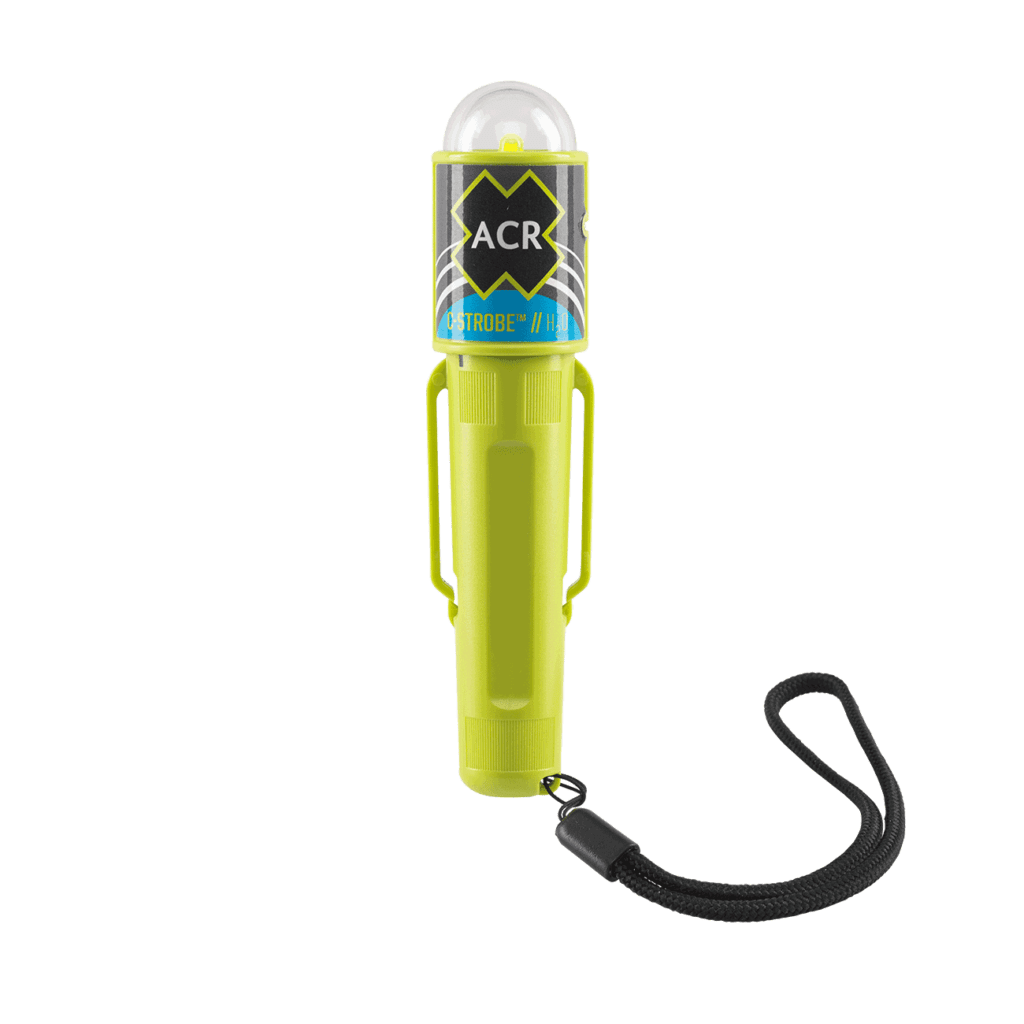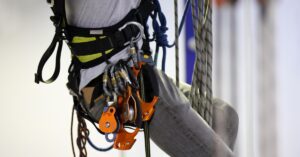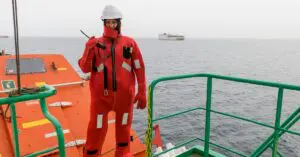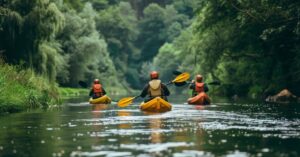When you’re on the water, safety is always a top priority, and personal flotation devices (PFDs) are essential for keeping you afloat. But when visibility is crucial—especially in low light or during rescues—attaching a strobe light to your PFD can make all the difference.
In this guide, we’ll walk you through how to securely attach a strobe holder loop to your PFD, ensuring your light stays in place when you need it most. We’ll cover the tools required, step-by-step instructions, and a few tips to ensure you’re fully prepared for any situation.
Why You Need a Strobe Light on Your PFD or Life Vest
In an emergency situation, especially in low-visibility conditions, a strobe light on your personal flotation device (PFD) can be a lifesaver. Whether you’re boating, kayaking, or involved in water rescue operations, visibility is key to being located quickly.
A strobe light attached to your PFD ensures that rescuers can spot you even in the darkest or foggiest conditions. This small addition to your safety gear greatly improves your chances of being seen, making it a critical component for anyone who spends time on the water.
Tools and Materials Needed for Attaching a Strobe Holder Loop to Your Life Jacket
Before you begin attaching a strobe holder loop to your PFD, it’s essential to gather the right tools and materials. Having everything ready ensures the process is smooth and efficient, saving you time and frustration. Let’s break down the essential items you’ll need and some optional tools that can make the task even easier.
Essential Tools
To securely attach a strobe holder loop, you’ll need a few basic tools:
- Sewing Kit: For attaching loops using durable thread, particularly if the loop needs to be sewn onto fabric.
- Adhesive: Strong, waterproof adhesive works well if sewing isn’t an option or as extra reinforcement.
- Lash Tabs or Specialized Clips: If your PFD has lash tabs, you can clip the strobe loop directly onto them for a secure fit. Alternatively, specialized clips can be used depending on the design of your PFD.
- Lighter (Optional): If you’re working with straps that may fray, sealing the ends with a lighter can keep everything neat and secure.
These tools cover the basics, but the materials and techniques can vary depending on your strobe holder loop and the design of your PFD.
Choosing the Right Strobe Holder Loop
Not all strobe holder loops are created equal, so it’s important to choose one that fits both your PFD and your strobe light. For example, the PFD strobe holder loop from ACR is specifically designed for life jackets and provides a reliable attachment point for emergency signaling devices.
When choosing a loop, consider:
- Durability: Ensure the loop is made from strong, weather-resistant materials that can withstand harsh outdoor conditions.
- Waterproofing Features: Look for loops and fasteners that won’t degrade or rust when exposed to water, as this is crucial for any gear used in aquatic environments.
By selecting the right strobe holder loop and having the appropriate tools, you’ll be set up for success when attaching your strobe light to your PFD.

Step-by-Step Guide to Attaching the Strobe Holder Loop to Your PFD
Attaching a strobe holder loop to your PFD ensures that your emergency light is always securely in place. Follow these step-by-step instructions to correctly attach the loop, and you’ll be ready for any situation on the water.
Step 1: Preparing the PFD and Strobe Holder Loop
Before you start attaching the loop, first identify where on the PFD you want to place it. Ideally, this should be a spot that is easily accessible and visible, such as near the shoulder or upper chest area. Use a marker to lightly outline where the loop will be attached, ensuring it doesn’t interfere with other safety features or comfort.
Tips:
- Choose a location that won’t be obstructed by other gear.
- Ensure that it’s high enough for the strobe light to remain visible above water when you’re in it.
Step 2a: Using Lash Tabs to Attach the Strobe Holder Loop
If your PFD has built-in lash tabs, attaching the strobe holder loop is quick and easy. This method keeps the strobe light firmly in place without the need for permanent modification, which is ideal for those who may want to remove or switch out their strobe light holder.
Key Instructions:
- Insert one end of the loop through the lash tab, pull it through, and fold it back over itself.
- Use a secure clip to fasten the two ends together, ensuring no slack.
- Test the tightness by gently tugging on the loop to ensure it stays in place.
Step 2b: Attaching the Loop with Adhesive or Clips
If your PFD lacks lash tabs, adhesive or clips offer alternative attachment methods. Apply a waterproof adhesive in a thin, even layer, pressing the loop onto the fabric. Allow the adhesive to set as per the manufacturer’s instructions (typically 24 hours). For clips, attach the loop to straps or edges of the PFD.
Tips:
- Test adhesive strength after drying by lightly tugging on the loop.
- Clips are quicker but might not be as secure long-term compared to adhesive.
Pros and Cons:
- Adhesive: Easy to apply but may not last as long in extreme conditions.
- Clips: Simple to use but might not be as stable as other attachment methods over time.
Step 2c: Attaching the Loop Using Stitching
For a more permanent solution, you can sew the strobe holder loop directly onto your PFD. Be sure to use heavy-duty, waterproof thread and a durable stitch, such as a box stitch, for extra security. However, keep in mind that sewing directly onto a PFD could invalidate coast guard certifications, so check your manufacturer’s guidelines first.
Reinforcement Tips:
- Double up on stitches to ensure maximum strength.
- Test the durability of your loop by gently pulling on it to ensure it’s secure.
- Use waxed thread to prevent water damage and ensure the loop holds up in wet conditions.
Ensuring Your Strobe Light Is Secure
Once your strobe holder loop is attached, it’s critical to make sure the strobe light is secure and will perform in an emergency. Begin by giving the light a firm, yet gentle, tug to test the strength of the attachment. If it shifts or feels loose, revisit the connection—tightening straps or reinforcing clips if necessary. After confirming a stable fit, check that the strobe light turns on and off properly. Lastly, simulate wearing your PFD, ensuring the light remains visible from all angles, especially when submerged.
Also, just because your strobe light is secure right now doesn’t mean it will stay that way. Periodically check the strobe holder and light for wear and tear, especially if used in harsh conditions.
Other Important Safety Accessories for Your PFD
In addition to a strobe light, there are several other safety accessories you can attach to your PFD to enhance protection and visibility. These items ensure you’re fully prepared for emergencies on the water, whether you’re signaling for help or cutting through obstacles.
Whistles and Sound Signaling Devices
A whistle or sound signaling device is a simple yet crucial addition to your PFD. In situations where visual signals may not be effective, especially in foggy or low-visibility conditions, sound travels farther and can help attract attention. Attaching a safety whistle to your PFD ensures you have an audible way to call for help when needed.
Reflective Tape and Markers
Reflective tape and markers are excellent tools for increasing your visibility at night or in low light. Applying reflective materials to your PFD makes you more noticeable to rescuers. The best spots for placement include the shoulders, upper chest, and back, where light is most likely to reflect. Be sure to clean and dry the surface before applying reflective tape to ensure long-lasting adhesion.
Rescue Knives
Carrying a rescue knife can be a lifesaver if you need to cut through tangled ropes, fishing lines, or other obstructions. A rescue knife should be securely attached to your PFD in an easily accessible location, such as a sheath mounted to the shoulder or waist straps. Make sure it’s in a place where you can quickly grab it in an emergency.
Personal Locator Beacons (PLBs)
A personal locator beacon (PLB) is a powerful tool for pinpointing your exact location during an emergency. When activated, a PLB sends out a signal to rescuers, helping them find you quickly. Attach the beacon to your PFD using built-in loops or straps, ensuring it’s secure but within reach for easy activation. PLBs are particularly useful in remote or offshore environments where traditional signals may not work.
Hydration Systems
For longer water-based activities, integrating a hydration system into your PFD can help you stay hydrated without sacrificing mobility. A hydration bladder can be attached to your PFD, typically on the back or side, with the hose positioned for easy access. Ensure the system doesn’t interfere with your range of motion or other safety features.
Stay Safe on the Water: Properly Attach Your Strobe Light to Your PFD or Life Vest
Securing your strobe light to your PFD is a simple step that can significantly improve your safety on the water. By ensuring that your strobe light is properly attached, you increase your chances of being seen in an emergency, especially in low-visibility situations.
Regularly check your gear for wear and tear, and make sure all attachments, including your strobe light and other accessories, are secure before heading out. Staying vigilant with your equipment can be the key to staying safe.




